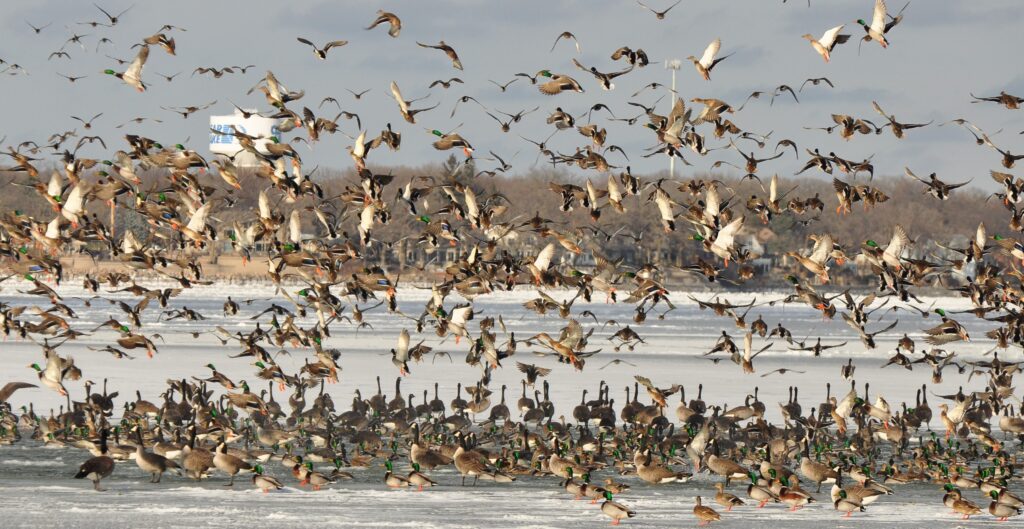Photography courtesy of Lowell Washburn, all rights reserved.
Following a year of presumed absence, highly pathogenic avian influenza [HPAI] is sweeping through Iowa waterfowl populations. This time, the outbreak is occurring due to a new and lethal [D1.1] variant of the avian influenza virus. As wintering ducks and geese concentrate into remaining areas of open water, the escalating effects of the deadly flu virus have become increasingly obvious to a concerned public. Reports of dead or dying birds have skyrocketed since early December, according to State Wildlife Veterinarian, Dr. Rachael Ruden.

The largest die offs are occurring across the northern half of the state where crowding and weather-related stress is greatest, says Ruden. From Sweet Marsh to West Lake Okoboji to Mason City, sick birds have become a common sight during the past two weeks. Affected birds typically appear uncoordinated, may swim in circles, are lethargic, and are reluctant or unable to fly when approached. On some areas, the ice is littered with fresh or partially scavenged carcasses. Although a variety of bird species have been exposed to the virus, Canada geese are suffering the greatest mortality followed by wintering trumpeter swans.
At Winnebago County’s Rice Lake, 175 goose carcasses and 16 dead trumpeter swans were counted on December 18. Additional carcasses may go undetected. At Clear Lake, for example, DNR officials reported that more than 40 dead geese had drifted against the edge of a north shore airhole on December 17. And although numerous sick geese could be seen on the ice on December 18, all 40 carcasses had completely vanished – pushed under the ice and out of sight by gusty northwest winds. It is likely that other sick or dead birds disappear as they are scavenged by eagles, red fox, and coyotes. At least one Clear Lake goose carcass was dragged away by raccoons on December 18.
Iowa is not alone in the latest outbreak of the deadly flu virus. Since the new [D1.1] variant was first detected in the Pacific Northwest, state vets have reported die offs occurring in Nebraska, North Dakota, South Dakota and Minnesota. Located directly to our north, a massive die off of waterfowl occurred in central Minnesota during late November.
“It looks like the new variant that emerged in Washington and Oregon is ripping through wild populations and there is little or no cross protection in the wild birds’ immunity, causing illness and death. This looks like a serious situation change from what the picture looked like a couple of weeks ago,” said Dr. Jill Nezworski, Blue House [Minnesota] Veterinary LLC.
“This is the first time since 2022 that HPAI virus has affected wild birds in North America at such a large scale,” noted Ruden. “Although mallards and other dabbling ducks often harbor the virus, they may remain healthy while spreading the virus to other populations like Canada geese. Ducks tend to be less affected; Canada geese tend to die.”

Although Canada geese comprise the majority of avian mortalities, other species – including blue jay, red-tailed hawk and great horned owl — have also succumbed to the virus. Although a large number of bald eagles are currently scavenging on goose carcasses, there has been no confirmation of sick birds. Although a woman in California was hospitalized on December 17 after handling a bird infected with the same strain of avian influenza currently circulating through Iowa goose populations, the risk of contracting avian flu from wild birds remains very low, according to the U.S. Department of Agriculture’s Animal and Plant Health Inspection Service.

But having said that, the USDA is also cautioning against handling wild birds that are obviously sick or dead. The Ag Department also recommends that hunters wear disposable gloves while cleaning game and hunters should wash their hands or use sanitizer immediately afterward. Even if a bird has been exposed to or is harboring avian flu virus, cooking game or poultry to a temperature of 165 degrees F will effectively kill avian flu viruses.
“There are still plenty of birds out there that are not impacted,” says Ruden. “All we are saying is that people [hunters] should use common sense when handling or cleaning wild game and avoid birds that appear suspicious.”

 Susan Judkins Josten
Susan Judkins Josten Rudi Roeslein
Rudi Roeslein Elyssa McFarland
Elyssa McFarland Mark Langgin
Mark Langgin Adam Janke
Adam Janke Joe Henry
Joe Henry Sue Wilkinson
Sue Wilkinson Tom Cope
Tom Cope Kristin Ashenbrenner
Kristin Ashenbrenner Joe Wilkinson
Joe Wilkinson Dr. Tammy Mildenstein
Dr. Tammy Mildenstein Sean McMahon
Sean McMahon